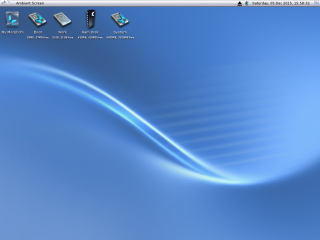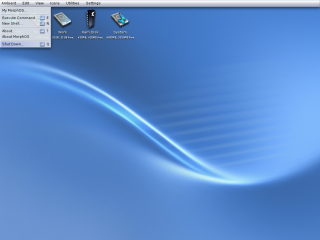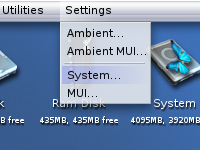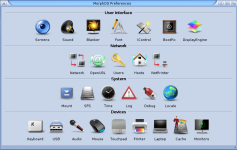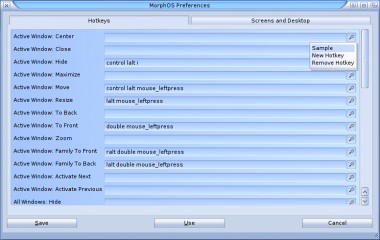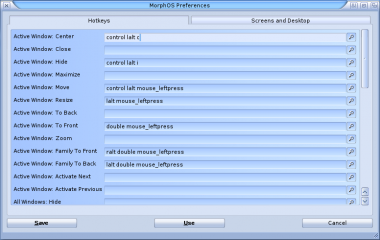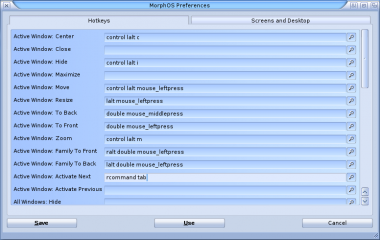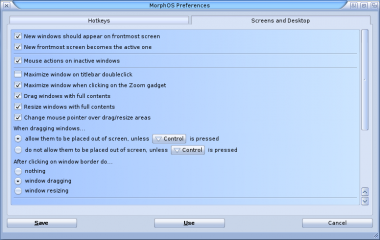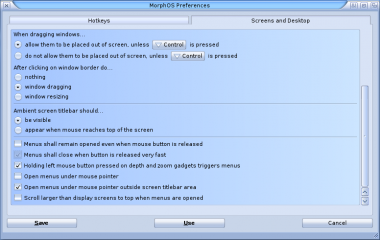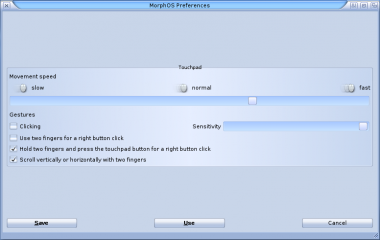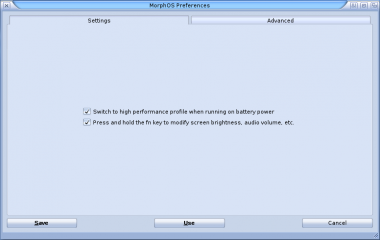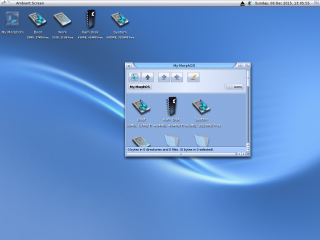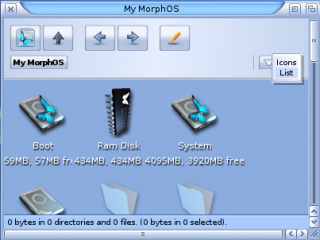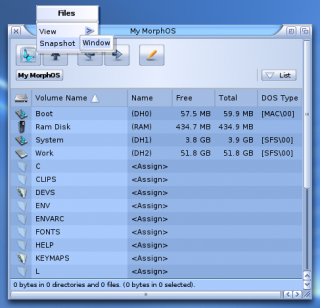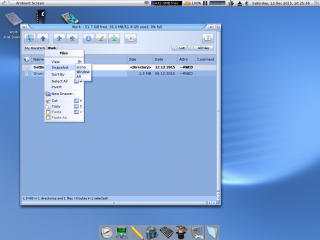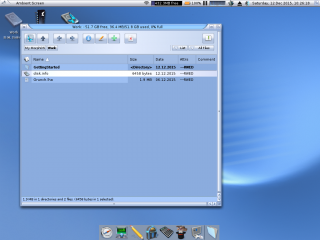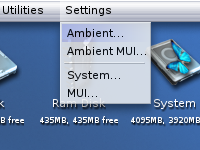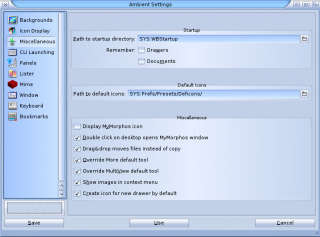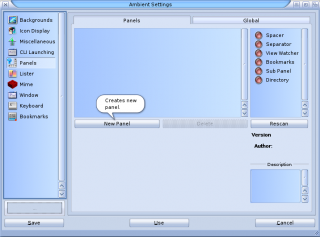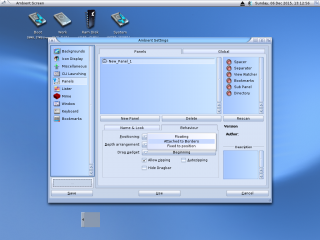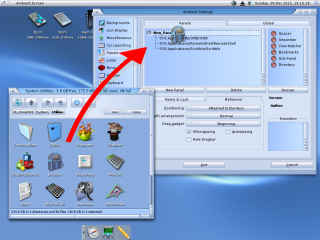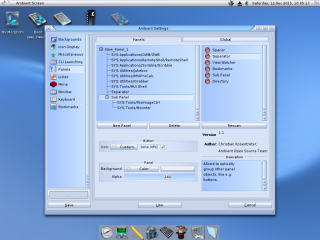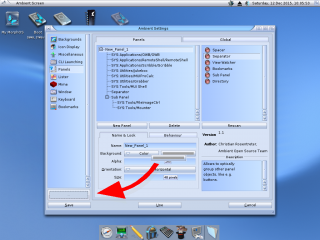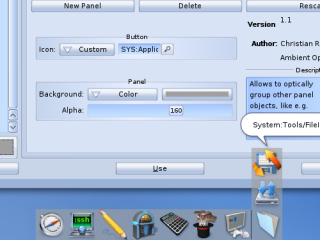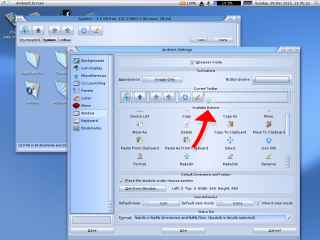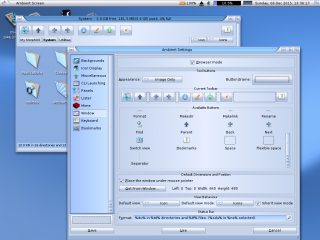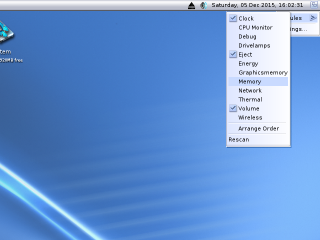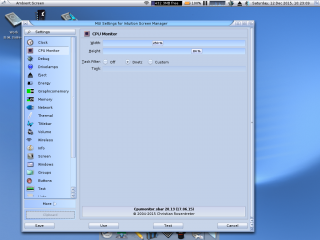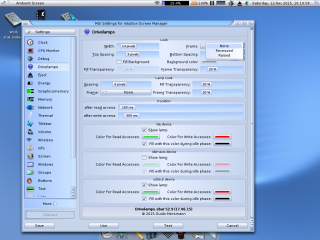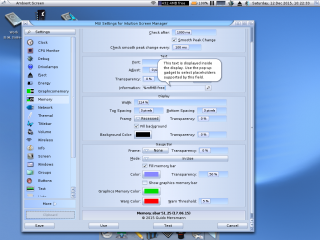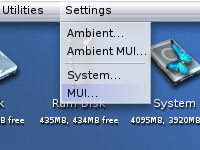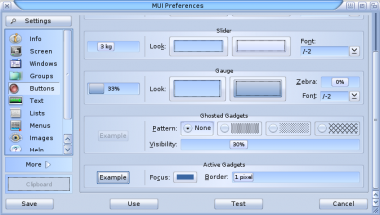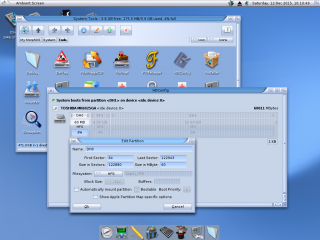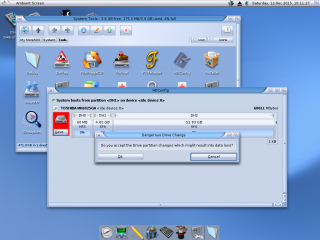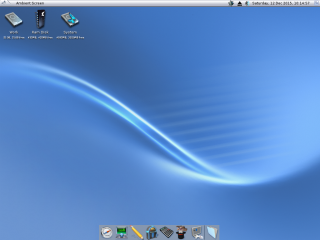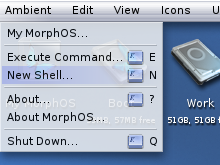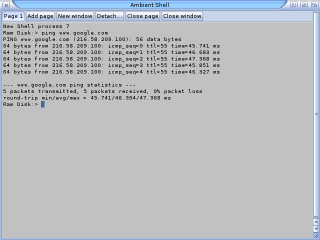Getting Started
From MorphOS Library
Contents
- 1 A Beginner's Guide to MorphOS
- 2 Getting Comfortable with the User Interface and the Ambient Desktop
- 3 Installing, Updating, and Configuring the Essential Software
A Beginner's Guide to MorphOS
You have installed MorphOS to a compatible machine, but... now what? You could always go and install a pre-configured package like Chrysalis, but you would end up with a system configured for someone else's taste and you still wouldn't know how to actually use the operating system. If you are in this situation and you would like to learn how MorphOS works, this is a tutorial for you! The tutorial will guide you through the things you should do and notice after a fresh install, with practical examples from basic configuration options to installing new software. It won't cover all the details and is just an opinion how to proceed, but it should give you some knowledge how to continue on your own and make your own decisions.
Getting Comfortable with the User Interface and the Ambient Desktop
The First Boot
After a boot you're presented with the plain looking Ambient, the desktop environment of MorphOS. The first thing you should learn is to get familiar with the basic usage, and to tune the usability settings so that they won't annoy you. The worst thing is if a user plays around a bit and just curses at the system if it doesn't work like expected or wanted. You aren't forced to just one kind of behaviour with MorphOS!
The right mouse button is widely used on MorphOS and if you're using a device without a physical button for it, check the tips over here. Pressing the right mouse button over the Ambient screen opens Ambient's pulldown menus where you can find few important options. For example, options to shut down the system, to open a new shell window, or to open system settings.
System Settings
The MorphOS Preferences application is used to edit system-wide settings. It can be launched from the Ambient's pulldown menu by selecting the "Settings->System..." menu option or by browsing to the System:Prefs/ drawer and double clicking the Preferences icon.
Screens
If MorphOS didn't get the optimal resolution of your monitor with DDC, a different screen mode can be selected from the Screens settings. If the wanted mode isn't seen there, open the Monitors settings instead to create a completely new mode.
If you have a graphics card with low amount of memory, you can try to get the memory consumption smaller by disabling the Enhanced Display setting (3D accelerated graphics functions for 2D screens) or by reducing the color depth. More information can be found from here.
MorphOS skins (themes for the graphical appearance) can also be changed from the Screens settings.
IControl
IControl settings are the most important settings for the overall usability experience. This is the place to look to avoid the usual comments like "Why doesn't X work like Y in the other OS?", "Why there isn't a feature Z?", "I can't use a system like this!". Everyone should check these settings first before going any further.
Hotkeys
MorphOS has many nice features to be used with keyboard shortcuts or mouse buttons, but only few are activated by default. Lets activate more!
To add a new hotkey for the wanted function click the popup button on the right side, select "Sample", and press the wanted keyboard combination. The pressed combination is then recorded to the corresponding line and should be shown there. Repeat the procedure if you didn't get it as wanted on the first try. Changed settings will be taken in use after you click Save or Use button.
Here is how to set the "control left-alt c" keyboard combination to center the active window on screen:
Here are some other recommendations to activate, but feel free to use your own preferences for the hotkeys:
- Active Window: To Back - double click with the middle mouse button, to send a window back of other windows.
- Active Window: Zoom - "control left-alt m", to toggle between maximizing and minimizing of a window.
- Active Window: Activate Next - "left-command tab", to have the alt-tab functionality found on many other operating systems. Using ctrl-tab or alt-tab isn't recommended because they would overlap with the shell's functionality on MorphOS. Command-tab happens also be the same with OSX.
Note: You can also add several hotkeys for a function by selecting the New Hotkey option from the popup button's menu.
Screens and Desktop
Important options how windows and menus behave can be found from the Screens and Desktop settings.
I'd recommend to turn on the Maximize window when clicking on the Zoom gadget option. The Zoom gadget will then toggle the window size between the full screen (with screen title bar still visible) and the initial window size and position. I find it much more comfortable than the legacy placement between two obscure positions. The previously configured Zoom hotkey will also work better with this option enabled.
If you prefer to be able to drag windows out of the screen without pressing any qualifier key, like on mainstream systems, select the When dragging windows... allow them to be placed out of screen, unless Control is pressed option.
The default behaviour of the pulldown menus may be a bit unfamiliar for the old Amiga users, but there are several options to get them as wanted. I like to disable the Menus shall remain opened even when mouse button is released option and enable the Open menus under mouse pointer outside screen titlebar area option.
Touchpad
If you're using a laptop system, check the Touchpad setttings. You might want to disable clicking from the pad to avoid any accidental clicks.
Laptop
If you're not a Mac user, you might find it odd that you need to press the fn key when using the function keys to normal activities, and not when modifying for example the screen brightness. The Press and hold the fn key to modify screen brightness, audio volume, etc. option will change the functionality the other way around.
Some systems also have the Automatic LCD brightness and keyboard backlight control option here. Disable it if you're annoyed by changing lightning.
Ambient Windows
The first icon you see on the Ambient desktop is the "My MorphOS" icon. By double clicking it you'll get a window with icons of all volumes and assigns found in the system, it works like a root directory with a quick access to different locations.
If you find it a bit clumsy in the icon mode, like I do, you can change the view to the list mode from the cycle button on the right side of the window.
With the default settings Ambient doesn't remember the changed mode or other window properties next time you open it, but you can right click the window border or an empty area on the file lister to get a window context menu and select the "Snapshot->Window" option to save the window properties. Default position and size for a window can be saved that way too. If you did define the centering hotkey earlier, you can try it now :)
The same can be made for the normal directory windows too. While "My MorphOS" window settings are exceptionally saved to Ambient's configuration files, normal directories' settings are saved to an icon file (a file with .info extension). If you change and save the mode for the Work: partition for example, you see a disk.info file appearing there.
Ambient Settings
Ambient is actually a separate application itself and it has its own settings separated from the general system preferences. The previously mentioned system settings affect to all programs and screens, but strictly desktop related settings are found in the Ambient settings. The Ambient Settings window can be opened by selecting the "Settings->Ambient..." option from the Ambient's pulldown menu.
Miscellaneous
The Miscellaneous page on the Ambient settings has a nice option to get the My MorphOS window opened when double clicking anywhere on the empty area of the desktop. It really speeds up the working when you don't have to move the mouse a long way to the top corner or dig the icon out from under some other windows. Enable it with the Double click on desktop opens MyMorphOS window option.
The My MorphOS icon is just wasting the space on the desktop after the previous setting and you can hide it by disabling the Display MyMorphOS icon option.
If you like to have a bit more eye candy on the context menus, you can also enable the Show images in context menu option while you're here.
Panels
Many new users are wondering if there is any kind of dock application on MorphOS, because there isn't any shown by default. MorphOS has panels for that and you can have as many panels as you want on the desktop, arranged horizontally or vertically. The panels have features like zipping to hide and unhide them, sub panels and other Panel Object plugins, etc. There just isn't any configured by default and user can create a panel or panels how he likes.
To create a new panel, open the Panels page on the Ambient settings and click the New Panel button.
An empty panel can be dragged anywhere and you can look some of its settings on Name & Look and Behaviour tabs. If you want to place the panel to a screen border the Attached to Borders option makes it easier. The Alpha option controls the transparency of a panel, but it only works if the Enhanced Display option for the Ambient screen enabled and working. The same applies to the Hide Dragbar option too.
Programs can be added to the panel by dragging and dropping their icons to the panel list to the wanted position on the list tree, or to the panel itself. Items in the panel list can be rearranged by drag and drop too.
Available Panel Objects are listed on the right-hand side and they can be dragged and dropped to any position on the panel tree. All items on the panel may have their own settings, which are shown when an item is clicked once with the left mouse button. In this example picture a new sub panel has been created and its icon image is being changed to a custom one.
If you want to clone the color settings from the main panel to a sub panel, you can use the MUI clipboard to temporarily store a setting. Drag & drop the wanted color button to the clipboard button.
Then activate the sub panel settings and drag & drop the clipboard button to the sub panel's color button.
And here's a picture of the created panel and its sub panel in action. Remember to click the Save button. The panels also have a context menu when clicked with the right mouse button and you'll have a quick access to the panel settings and some other options there.
Window
Ambient windows are very configurable and users should at least check available buttons for the toolbar. Even adding few buttons can make a difference to the usability. The buttons and other items can be dragged from the Available Buttons list to the Current Toolbar group, and vice versa to remove them from the toolbar. All changes are updated in real time to any open Ambient windows.
In this example picture Makedir and Delete buttons are separated with the Space button and have been added in a row with other buttons. Also the Bookmarks button has been added as the last item on the toolbar. It stays always at the right border no matter how big a window is, because it's been added after the Flexible space button.
Screenbar Modules
Screenbar modules are plugins which can populate the empty area on the screen tittle bar with some useful information and usage. The modules are visible on every (MUI) screen, which makes them more useful than for example Panel Objects which are only seen on the Ambient screen and can be left under some other windows.
Screenbar modules can be enabled and disabled from the screen depth gadget menu. The menu also contains options to arrange the order of the modules and to change their settings. The menu can be accessed by pressing the right mouse button, or with a long left press, over the screen depth gadget.
Lets have a look how to configure few modules. Enable CPU Monitor, Drivelamps, and Memory modules, you can multiselect them at once and then reopen the screen depth gadget menu and select the Settings... option. Select CPU Monitor from the settings list. CPU Monitor is a bit narrow by default, so lets increase its width little.
Drivelamps has more configuration options. Enable the Show lamp option for usbscsi.device if you want to see access indicators for both HD and USB drives. The default look doesn't seem to be that good for two lamps, but you can tune it a bit. Disabling the Look frame (None) and selecting the recessed frame for Lamp Look does some wonders already. You can also adjust the spacing options, if the lamps don't seem to match with the height of CPU Monitor or other modules.
The Memory module shows free memory in percents by default, but it can be changed to other types too. Click the popup button on the Information line to see the options. The information line can have any text and for example a %mfMB free line would show a value of free memory in megabytes followed by the "MB free" text.
MUI Settings
MUI is the default GUI toolkit of MorphOS and its looks and behaviour can be changed on almost every aspect. Its basic philosophy is to offer as much freedom as possible to users by taking away as much work as possible from programmers. A user can modify the looks of MUI programs very drastically both globally and per program. It can be done by changing single settings or by loading complete themes (presets).
The most important thing for a new user is to understand the difference between the global settings and settings of individual programs.
The global settings are the default settings which will apply to any program using MUI. The global settings can be changed by selecting the Settings->MUI... option from the Ambient's pulldown menus or by double clicking the SYS:Prefs/MUI icon.
Each MUI program can also have its own MUI settings which will override the global settings, but be careful when changing for example the looks of an individual program. If you decide to change the global theme later, the changes made to the individual programs might not fit the global theme anymore. The own MUI settings for a program can usually be found from the program's pulldown menu or from the window's popup gadget menu. Ambient's own MUI settings are found from the Settings->Ambient MUI... option in the Ambient's pulldown menus.
Lets change couple options in the global MUI settings for an example. Open the global MUI settings window.
The default ghosting effect for buttons is a bit old-fashioned raster effect and it will look much better with just reduced visibility. Select the Buttons page and click the None option for the ghosted gadgets. The visibility can be changed with the slider below, but the default value will be fine too. You'll see the changes in real time on any MUI program, the Test button is a bit obsolete with the latest MUI. I also like to make the Active Gadgets Border bit smaller from the original size. Click the Save button when you're satisfied.
The Settings button on the top left corner gives a popup menu with options to reset the settings or load different presets.
All MUI settings get saved to the ENVARC:MUI/ directory. If you mess too much with some settings, the last resort to revert the settings to default is to remove the settings files from that directory or restore them from a backup.
Hiding the Boot Image Partition on Macs
On Macs you'll have a small HFS formatted partition which contains few files needed to boot the system. The files are only used by Open Firmware at boot time and the user or MorphOS itself don't normally need them for anything. Open Firmware can access the partition even if it's not mounted on MorphOS. We'll have a little cleaner desktop when we disable the auto mounting of it, and the crucial boot files will be safe from accidents then too.
Launch the Tools/HDConfig program and click on the small HFS partition, its name should be DH0:. Disable the Automatically mount partition option and click OK.
Click the Save button which is on the red area on the left side and accept the changes.
Next time you boot the system, the partition isn't shown on the desktop. If you need to access it later for some reason, it can be mounted temporarily with the Tools/Mounter tool.
Installing, Updating, and Configuring the Essential Software
Checking the Network Connection
Before continuing to installing new software, lets check if your machine is properly connected to Internet.
Open the shell by selecting the Ambient->New Shell... option from the Ambient's pulldown menus, or by pressing rcommand n keyboard combination or doubleclicking the SYS:Tools/MUI Shell icon.
Check the Internet connection by pinging some hostname on the Internet, type for example ping www.google.com on the shell. If you get replies from the host, the connection is OK and you can proceed by pressing CTRL C to quit the Ping command and closing the shell window. If you don't get any replies with time values, quit the pinging by CTRL C combination and read the Configuring a Network Connection tutorial.
